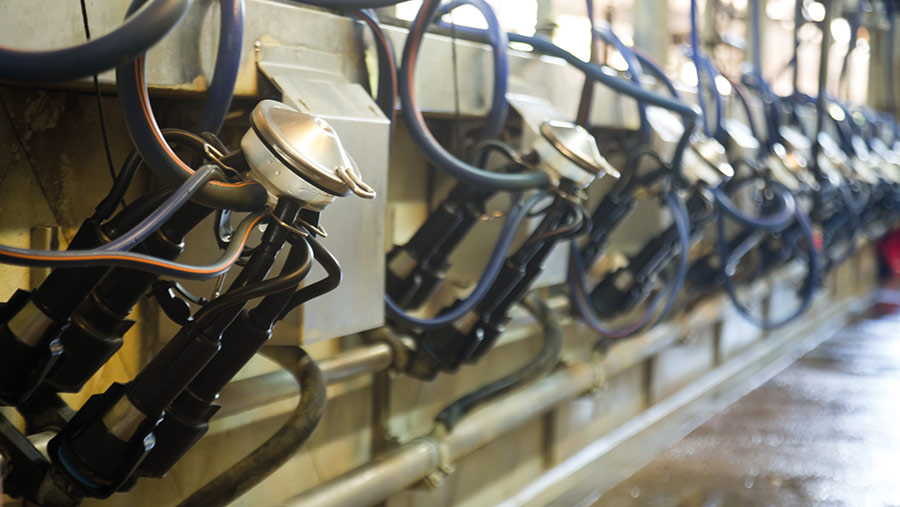6 ways to reduce the risk of high bactoscan in bulk milk
 © JackF/Adobe Stock
© JackF/Adobe Stock Numerous factors can influence the levels of bacteria in bulk milk.
While there can be ‘weird and wonderful’ causes of high bactosan – the main measure of milk bacterial load in the UK – most issues are down to basic errors that can be easily identified and corrected.
See also: 7 ways to make the most of milk recording data
Below are some of the areas that the farm team can evaluate themselves.
Key areas of bactoscan risk
There are three areas where errors can lead to high levels of bacteria:
- Direct contamination of milk. This can be caused by high bacterial load on the teats, unhygienic milking practices, or infected quarters that have not been detected or withheld
- Build up of bacteria in the milking machine, which arises from inadequate circulation cleaning
- Bacterial contamination within the bulk tank. This is the result of slow milk cooling or poor disinfection of the tank surface.
Problems in these different risk areas will lead to different groups of bacteria being present in the bulk tank. Submitting samples from the bulk tank to a milk-quality laboratory will show what different bacterial groups are present and help identify which risk factors to focus on.
It is important to run these tests on several different bulk tanks to ensure the pattern of bacteria is consistent.
To avoid milk quality being compromised, focus on the following six areas of management:
1. Teat skin contamination
Visibly dirty teats will always have high bacterial levels, but teats can also have high bacterial load when they appear clean.
- Identify and eliminate areas of environmental challenge in housing, grazing and transit ways.
- Match your teat-cleaning regime to the level of challenge – dry wiping may be sufficient for very clean teats, while a thorough dip and wipe may be necessary for high levels of contamination.
There are various other options between these extremes.
2. Milking hygiene
Reviewing the milking process can help to reduce the risk of contamination.
- Optimise milking machine settings and routine to reduce stress-induced dunging in the parlour
- Control flies to reduce dunging, stamping, tail swishing and liner squawks. This will help prevent spread of faeces on to the milking equipment
- Avoid using powerful hoses, as these splash faeces into an aerosol, covering all the milking equipment
- Adjust detachment settings to prevent the clusters hitting the deck and getting contaminated
- Review mastitis detection to stop infected quarters entering the tank.
3. Plant cleaning
Machine washing requires multiple components to be correct to ensure successful disinfection and removal of residues.
- Use a protocol based on a warm water pre-rinse, chemical circulation, and water post-rinse (possibly with a sanitiser) at every milking. Cutting costs by deviating from this is usually a false economy.
- Use milkstone remover regularly to prevent residue build-up, but be aware that overuse will reduce the lifespan of rubber parts.
- Check that your chemical circulation volume is a minimum of 10 litres/cluster (for machines with more “pipework per point”, up to 14 litres/unit may be needed). Calculate the amount of chemical required for the total volume and check this is actually being added.
- Monitor the temperature of the wash fluid at both start and finish of circulation to ensure it stays within the recommended range for that chemical.
- Check all clusters and meters are being flooded.
A full evaluation of the success of slug washing of the milk line requires technical expertise and equipment. However, watching to see the receiver is rattled gives a basic indication that slug transit is adequate.
4. Milk cooling
A range of regular checks can help ensure milk is cooled sufficiently.
- Aim for milk temperature in the tank to be below 4C within 30min of the last cow being milked to reduce bacterial multiplication rates.
- Check that previously cooled milk is not warmed too much by new milk entering at the following milking.
- Ensure regular servicing of the tank refrigeration to rule out gas leaks or compressor inefficiencies.
Often the biggest gains are made by improving pre-tank cooling, either by increasing plate-cooler capacity (adding additional leaves or a second plate-cooler) or by using glycol or chilled water instead of ambient water.
5. Tank cleaning
The following checks will highlight any aspects of tank management that need correcting:
- Catch the wastewater from the main wash to check volume, aiming for a minimum of 100 litres of wash fluid for every 10,000 litres of tank volume
- Measure chemical uptake and adjust according to total volume. Remember that uptake from peristaltic systems can change as pipes and wheels age
- Monitor the temperature read-out during wash. If you are struggling to maintain the temperature recommended for your wash chemical, either use warm rinses to preheat the surface before the main wash, or select products that do not require high temperatures
- Schedule regular visual assessments of the tank to check for areas missed by the sprayer heads. Common dead spots include down-facing paddle blades and upper surfaces (especially in top-feed systems).
6. Water quality
All three main sources of bacterial contamination – milking, plant cleaning and tank management – involve water use.
- Carry out regular sampling of natural water sources, such as spring water or boreholes, to check bacterial levels. Treatment of water with UV filters or chemical sanitisers can be helpful.
- Sample storage containers for contamination between source and end use.
- Monitor freezing point depression to check for significant contamination of milk by water, such as from a damaged plate cooler.
